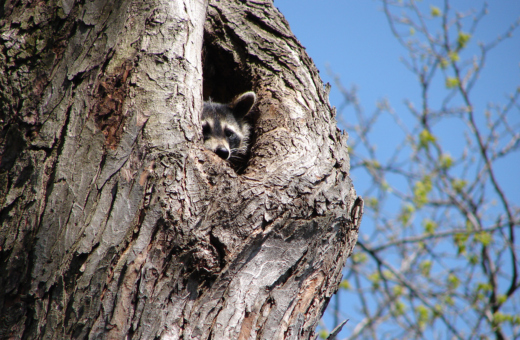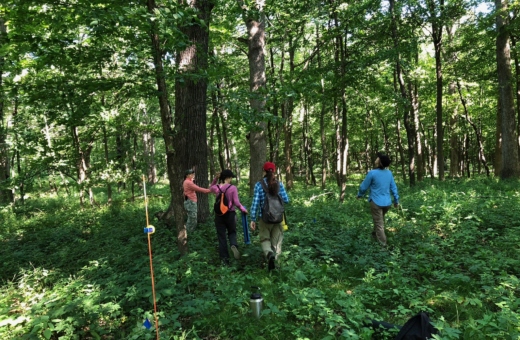Saving a Small Oak on a High Mountain
The Sierra Madre Oriental in northeastern Mexico is a land of clouds and mist. In these high plateaus, warm, tropical air from the Gulf of Mexico collides with cool mountain air and condenses, creating a narrow region with warm, humid air that is home to some plant species that live nowhere else. “To the east it is too dry, and to the west, too warm and tropical,” said Maricela Rodriguez, PhD, who works with The Morton Arboretum as Mexico and Central America coordinator for the Global Conservation Consortium for Oak (GCCO).
One of the unique plants of this cloud land is Quercus hirtifolia, an attractive small tree with glossy, dark green, wavy-edged, bristle-tipped leaves that look almost like Christmas holly and deep brown, shiny acorns. The species was only described by scientists in 2004, although its long been known to local people, whose names for it include encino negro, or black oak.
The tree is one target for a project of the Arboretum’s Global Tree Conservation Program (GTCP), which brings together local scientists and conservation leaders from Costa Rica to Mexico, along with botanic gardens and arboreta, to work toward sustainable conservation and management of rare trees and the ecosystems of which they are a part. The work includes locating the highest-priority species and areas for conservation, developing partnerships with local people to protect nature in their own regions, and replanting threatened trees.
Quercus hirtifolia is easy to identify. Within a few years after it was first described, scientists had mapped its distribution and confirmed that it is rare. Unlike the massive oak trees of forests in the United States and Europe, this small tree grows sparsely amid other oaks and pines on steep slopes 4,600 to 8,000 feet above sea level. It is ecologically important because it forms an understory in the forest and helps prevent erosion of the mountainsides.
In 2017, Quercus hirtifolia was listed as endangered on the Red List of the International Union for Conservation of Nature. Less than 10% of its native range is within protected areas, making it a high priority for conservation by the GCCO and the GTCP. “For us, this is an interesting and ecologically important species,” Rodriguez said.
To provide Quercus hirtifolia seedlings for replanting, more than 2,000 plants have been grown from acorns. Trees of the species also have been planted in 10 botanical collections worldwide, Including the Puebla University Botanic Garden, to make sure the species will survive even if it were to lose more ground in its wild habitat.
Preserving rare trees in places where people live and use the forest is a complex problem, and Quercus hirtifolia is a good example.
Like many other rare oaks, encino negro is often cut for firewood by local people, according to the Arboretum’s 2024 Conservation Gap Analysis of Native Mesoamerican Oaks. The slopes where it lives are probably too high and too steep to be cleared for lumber plantations—which is a threat to many other rare trees—but the species is affected when water is diverted for agriculture and when larger oak trees that are part of its ecosystem are cut for timber.
As with many rare trees that only grow in a small range, any loss of territory (for example, to mining or a change of habitat) could push the species closer to extinction.
“The most serious threat to its existence is probably climate change,” Rodriguez said. Research, the bedrock of the GCCO’s work, has indicated that, unlike many other oaks from humid areas, this species seems to grow poorly in warmer, drier situations.
Some plant species may be able to retreat to higher, cooler elevations as the climate warms, but since Quercus hirtifolia already grows so close to the mountaintops, “any change in the climate would give it little chance to migrate to more suitable areas,” she said.
The Morton Arboretum’s coordinated global action to conserve trees, and its important research in tree and conservation science, are among the reasons it has been designated as a member of the International Union for Conservation of Nature. The IUCN develops global conservation policies and practices that protect the planet’s plants and animals, and their habitats.
As an IUCN member, the Arboretum will have a voting role at its World Conservation Congress in October 2025 in Abu Dhabi, voting to define IUCN policy for the next four years. The Arboretum is among several arboreta and botanical gardens designated as IUCN members.
“This designation amplifies the Arboretum’s commitment to global conservation efforts,” said Jill Koski, the Arboretum’s president and CEO.
Quercus hirtifolia is one small tree in a limited area of a high mountain plateau. But everywhere The Morton Arboretum works to bring people together to save rare trees, that work helps protect the habitats of all the world’s plants, animals, and people.



